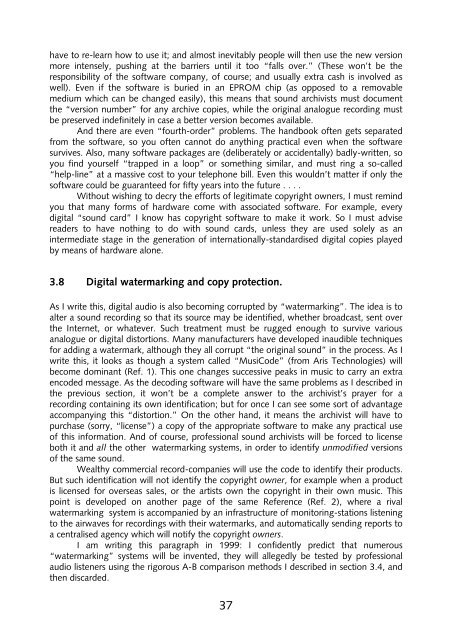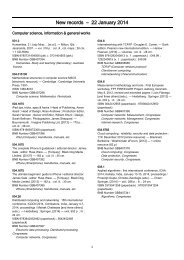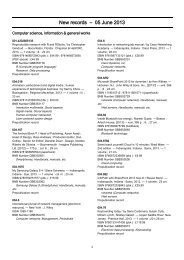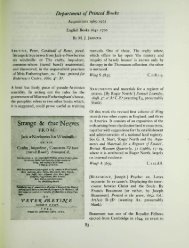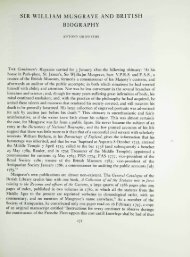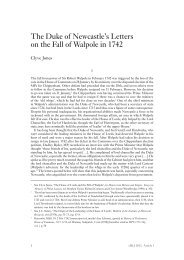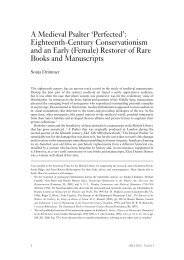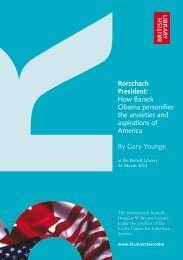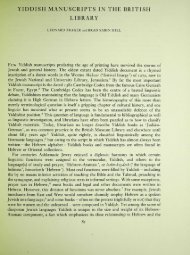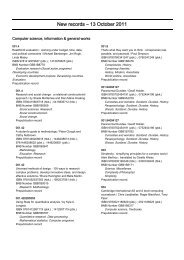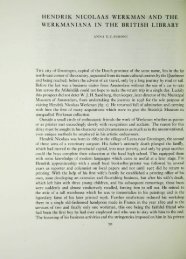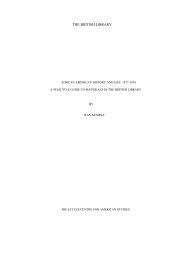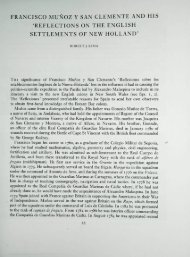MANUAL OF ANALOGUE SOUND RESTORATION ... - British Library
MANUAL OF ANALOGUE SOUND RESTORATION ... - British Library
MANUAL OF ANALOGUE SOUND RESTORATION ... - British Library
Create successful ePaper yourself
Turn your PDF publications into a flip-book with our unique Google optimized e-Paper software.
have to re-learn how to use it; and almost inevitably people will then use the new version<br />
more intensely, pushing at the barriers until it too “falls over.” (These won’t be the<br />
responsibility of the software company, of course; and usually extra cash is involved as<br />
well). Even if the software is buried in an EPROM chip (as opposed to a removable<br />
medium which can be changed easily), this means that sound archivists must document<br />
the “version number” for any archive copies, while the original analogue recording must<br />
be preserved indefinitely in case a better version becomes available.<br />
And there are even “fourth-order” problems. The handbook often gets separated<br />
from the software, so you often cannot do anything practical even when the software<br />
survives. Also, many software packages are (deliberately or accidentally) badly-written, so<br />
you find yourself “trapped in a loop” or something similar, and must ring a so-called<br />
“help-line” at a massive cost to your telephone bill. Even this wouldn’t matter if only the<br />
software could be guaranteed for fifty years into the future . . . .<br />
Without wishing to decry the efforts of legitimate copyright owners, I must remind<br />
you that many forms of hardware come with associated software. For example, every<br />
digital “sound card” I know has copyright software to make it work. So I must advise<br />
readers to have nothing to do with sound cards, unless they are used solely as an<br />
intermediate stage in the generation of internationally-standardised digital copies played<br />
by means of hardware alone.<br />
3.8 Digital watermarking and copy protection.<br />
As I write this, digital audio is also becoming corrupted by “watermarking”. The idea is to<br />
alter a sound recording so that its source may be identified, whether broadcast, sent over<br />
the Internet, or whatever. Such treatment must be rugged enough to survive various<br />
analogue or digital distortions. Many manufacturers have developed inaudible techniques<br />
for adding a watermark, although they all corrupt “the original sound” in the process. As I<br />
write this, it looks as though a system called “MusiCode” (from Aris Technologies) will<br />
become dominant (Ref. 1). This one changes successive peaks in music to carry an extra<br />
encoded message. As the decoding software will have the same problems as I described in<br />
the previous section, it won’t be a complete answer to the archivist’s prayer for a<br />
recording containing its own identification; but for once I can see some sort of advantage<br />
accompanying this “distortion.” On the other hand, it means the archivist will have to<br />
purchase (sorry, “license”) a copy of the appropriate software to make any practical use<br />
of this information. And of course, professional sound archivists will be forced to license<br />
both it and all the other watermarking systems, in order to identify unmodified versions<br />
of the same sound.<br />
Wealthy commercial record-companies will use the code to identify their products.<br />
But such identification will not identify the copyright owner, for example when a product<br />
is licensed for overseas sales, or the artists own the copyright in their own music. This<br />
point is developed on another page of the same Reference (Ref. 2), where a rival<br />
watermarking system is accompanied by an infrastructure of monitoring-stations listening<br />
to the airwaves for recordings with their watermarks, and automatically sending reports to<br />
a centralised agency which will notify the copyright owners.<br />
I am writing this paragraph in 1999: I confidently predict that numerous<br />
“watermarking” systems will be invented, they will allegedly be tested by professional<br />
audio listeners using the rigorous A-B comparison methods I described in section 3.4, and<br />
then discarded.<br />
37


